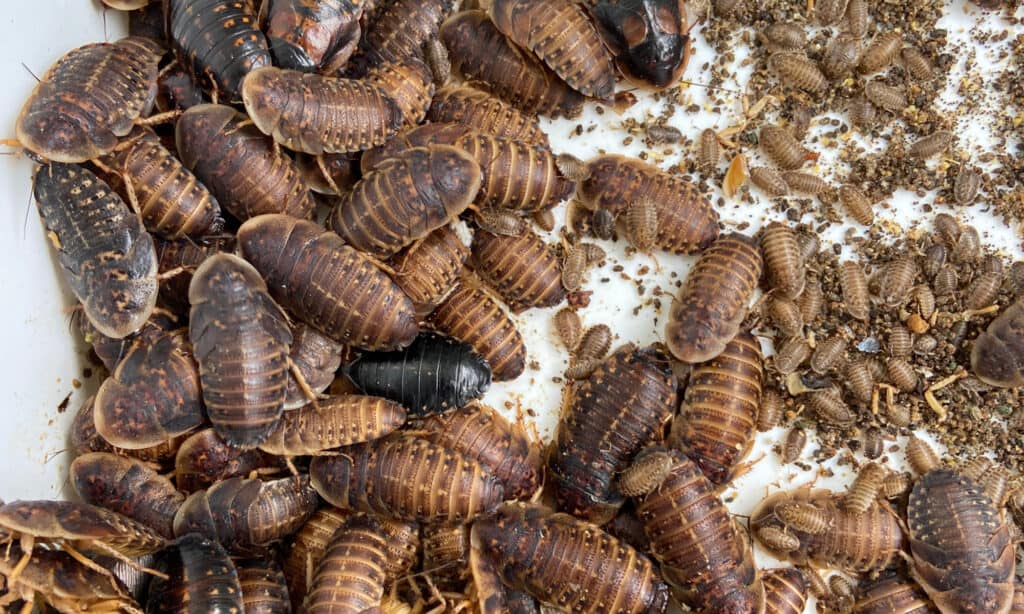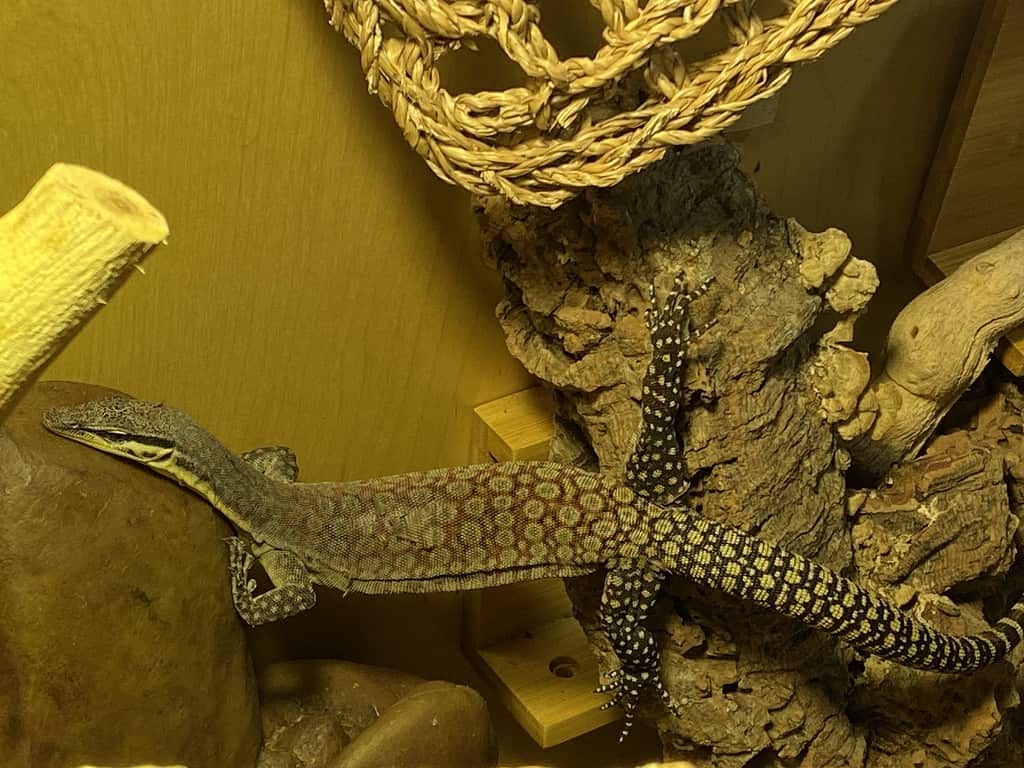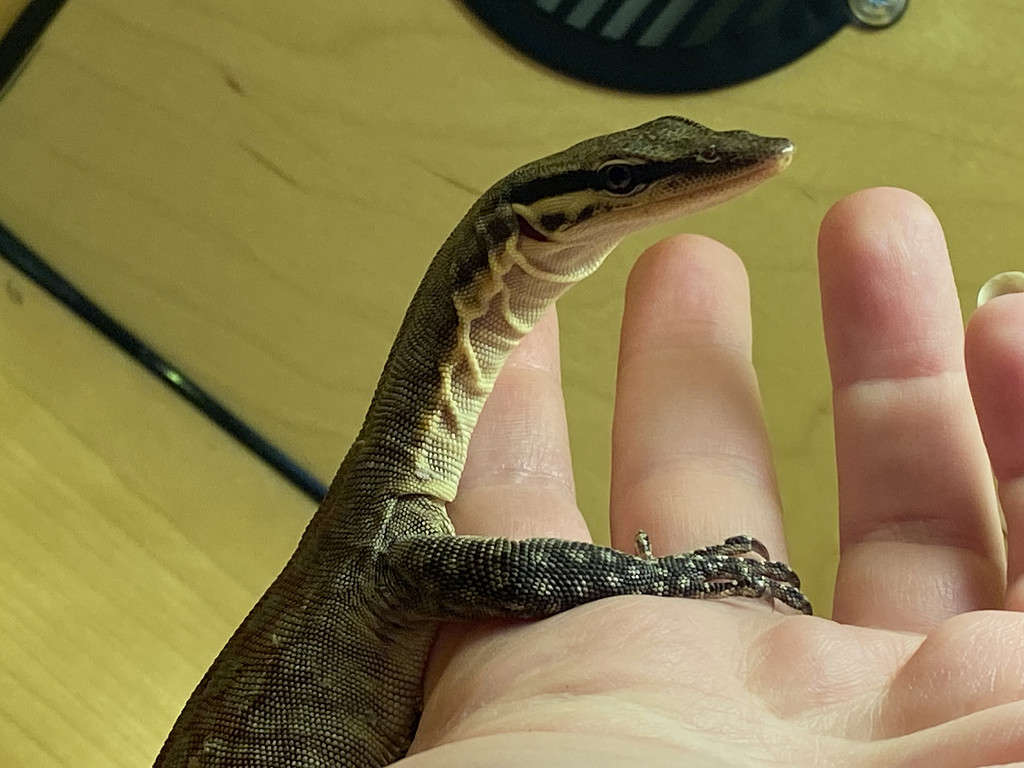The Kimberley rock monitor (Varanus glauerti) is a semi-arboreal desert monitor lizard endemic to Australia. As their name implies, these monitors hail from the remote Kimberley Rock region of Western Australia, known for its Aboriginal rock art. Some Australians call them Kakadu sand goannas since they also live in the Kakadu region of Northern Australia.
Kimberley rock monitors are growing in prominence among reptile enthusiasts. Originally restricted to Australia, American and European reptile breeders now have multiple generations of captive-born and bred (CBB) Kimberley rock monitors. Reptile keepers love these monitors for their beautiful colors, handleable size, and sociable personalities.
Kimberley rock monitors are easier to care for compared to other popular monitors like the Asian water monitor. They are extremely intelligent, curious, and playful. They’re an attractive pet lizard to prospective reptile keepers in small homes on account of their manageable size.
Is a Kimberley rock monitor a good pet? Is it the right pet reptile for you? Kimberley rock monitors definitely make amazing pets, but they require more patience compared to other pet lizards. Here’s what you need to know if you’re considering a Kimberley rock monitor.
Basic Facts About Kimberley Rock Monitors

Liora, the author’s pet, eagerly awaits interaction.
©A-Z-Animals.com/Rachel Presser
Kimberley rock monitors are long and slender. With elegant brontosaurus-like necks and flat snouts, they love to flatten themselves in and out of tight spaces. This includes rock crevices, tree bark, driftwood, and other areas where they can easily hide from predators.
They grow to about 3-4 feet long as adults and can live 15-20 years in captivity with good husbandry. Most of that length is their tails.
Even though they are desert monitor lizards, Kimberley rock monitors like humidity. When keeping one as a pet, it’s important to mist their habitat daily.
These lizards love to dig, burrow, and explore. They don’t require deep substrates like savannah monitors but need a blend of soft and rough substrates. This prevents torsion on their digits.
They also need a wide-ranging heat gradient. The basking area should reach 120°F. Since they like humidity and flattening into rock crevices, habitat decor should accommodate this. Decor and bulb placement should create cool and shady areas.
This monitor species is skittish and takes time to tame and socialize. Once they do though, they can become extremely affectionate towards the humans they regularly interact with. They don’t mind being solitary with frequent human interaction. If you want more than one Kimberley rock monitor, it’s prudent to keep the males apart. Females fare better living together, males often fight each other.
Kimberley Rock Monitor Diet

Dubia roaches of all sizes are a favorite meal for Kimberley rock monitors of all ages.
©suriyachan/Shutterstock.com
Kimberley rock monitors are primarily insectivores that like to chase their food. They will eat live crickets, dubia roaches, grasshoppers, and beetles. Sometimes they will eat superworms or grubs but prefer insects that crawl and hop.
Insects are their favorite food, but they will eat other small prey items. This includes rat and mouse pinkies, smaller lizards, and ground turkey. Scrambled eggs and hard-cooked egg whites are another favorite, with the shells left in for additional calcium.
Insects should be gut-loaded with a low-protein diet. Leafy greens or gut-loading powders made from dried vegetables should be the diet’s basis. Dust the gut-loaded insects with a calcium powder before placing them in your monitor’s enclosure. Insects and other foods should also be sprinkled with a multivitamin powder containing D3 once a week. Egg-laying female monitors need more D3 during the egg production stage.
Baby Kimberley rock monitors need to eat daily. Juveniles, which are 1-2 years old, can be fed every other day. Adults should eat 2-3 times a week, although they will hunt for loose insects in their enclosures when hungry.
Financial Considerations of Keeping a Kimberley Rock Monitor
The ongoing care and feeding costs of a Kimberley rock monitor are low when compared to other monitor lizards. However, a healthy and ethically obtained lizard and the proper enclosure have high upfront costs.
A CBB baby Kimberley rock monitor costs about $1,300-1,500. Wild-caught imports can be obtained for as little as $400. Wild-caught babies will often have health problems and trauma from the import process, or more likely, smuggling, given that these lizards can no longer be exported from Australia. This makes socialization longer and more difficult. CBB monitors are more readily available and less apt to have major health issues. Well-socialized CBB babies spend lots of time around humans from hatching, and this leads to a shorter bonding time.
Eggs and ground turkey are inexpensive and easily accessible, as are crickets. Dubia roaches can cost as much as $1-2 per bug depending on the size. Grasshoppers are harder and more expensive to obtain.
Kimberley Rock Monitor Habitat Costs
The best custom or modular habitats for this species can run anywhere from $300-700 on the low end to $1,000 and up on the high end. The enclosure should be made of wood because it’s the most efficient at trapping heat.
Because Kimberley rock monitors love to climb, they need a tall enclosure that’s at least 4 feet wide and 3 feet tall. They do not require a transitional habitat, but some reptile keepers opt to keep babies in smaller enclosures with fewer decorations to make them socialize faster. Larger and taller enclosures with more enrichment items and decoration make for superior husbandry.
Being part of the Odatria subgenus, dwarf monitors, and Kimberley rock monitors are under 4 feet, so you don’t need a spare room to house them. This makes them the ideal pet monitor for reptile keepers in apartments and other small living spaces.
They fare best with mixed substrate comprised of soft and hard elements. Coconut fiber or organic dirt mixed with orchid bark works well. Soft substrate only needs to be about 2-3″ deep with hard substrate sprinkled on top. Substrates should be changed every 3-4 weeks to prevent fungal and bacterial growth.
Since Kimberley rock monitors flatten themselves easily, “lizard-proofing” the enclosure doors may be necessary. The soft ends of Velcro strips can jam glass door gaps without hurting your lizard.
Basking and UVB Bulbs for Kimberley Rock Monitors

Liora gets a full-body bask a few inches under a 250W basking bulb.
©A-Z-Animals.com/Rachel Presser
Kimberley rock monitors require significant heat levels to metabolize their food and have a desire to eat. The temperature needs to be 90-100°F, with the basking area reaching 120°F. The cool side should be 80℉, with the temperature dropping to 70°F at night.
Depending on the size and height of the enclosure, a single clamp lamp or socket with a 100W basking bulb may be sufficient to achieve these temperatures. If the socket is too high, you may need a high-wattage bulb like the 250W PowerSun in the basking area. Thermogenic surfaces like rocks and ceramic tiles ensure a warm area for your monitor to bask.
Multiple clamp lamps with 75W bulbs aided by 1-2 ceramic heat emitters can achieve the ideal heat gradient. Ceramic heat emitters can make the gradient more precise without making the enclosure too bright.
There should also be at least one 10% UVB bulb. Basking bulbs can be changed as they burn out, but UVB bulbs must be changed every six months regardless.
Basking and UVB bulbs should operate 10-12 hours per day. Timer plugs or WiFi-controlled smart plugs can easily program this timing. Some of them can also be tuned with local sunrise and sunset to give your monitor a more natural setting.
Kimberley Rock Monitor Habitat Enrichment

Liora stretches and plays on cork bark, branches, and woven toys to exercise different muscles and hunt roaches.
©A-Z-Animals.com/Rachel Presser
These lizards need lots of different surfaces to climb on, play with, flatten themselves into, and hide. Branches are important for climbing and large flat rocks are what they gravitate to in the wild. They also like to climb bamboo bridges, cork bark, woven toys, and their humans.
Lots of playful enrichment focused on climbing and places to flatten makes for a happy and social Kimberley rock monitor.
The Rewards and Responsibilities of Your Very Own Kimberley Rock Monitor

Liora loves and trusts her human and chooses to interact this way!
©A-Z-Animals.com/Rachel Presser
Kimberley rock monitors make incredibly wonderful pets. Raising and socializing one is a fun and rewarding experience. They engage in many of the same fascinating behaviors as larger lizards, but they are more attainable for apartment dwellers.
Handleability is also a major plus. They love to be petted once they’re used to you. It is also unlikely that this lizard will bite you. They are more inclined to run than attack if scared.
However, this handleability doesn’t happen overnight. It takes a lot of patience to socialize a Kimberley rock monitor. They need time to get used to you. Because they’re so skittish and fast, you need to be mindful to lizard-proof the room where the enclosure is placed. Even if this monitor adores you, it runs incredibly fast and can be difficult to pull out of hiding. Between this aspect and their cost, a Kimberley rock monitor isn’t a good pet for families with young children. It should only be your first lizard if you’ve sufficiently researched their care requirements and monitor psychology.
But once your Kimberley rock monitor forms a bond with you, it demands a lot of attention! They’re still monitor lizards, which are highly intelligent and have a long memory. Once one chooses you as their human, they can demand as much attention as a dog! It’s amazing to have a pet lizard that’s happy to see you and wants to cuddle all the time. But if you want a beautiful and intelligent lizard, you don’t have to interact with as much, a green tree monitor is an excellent show pet.
With the proper enclosure, enrichment, and care, you will have many happy years with your Kimberley rock monitor.
The photo featured at the top of this post is © A-Z-Animals.com/Rachel Presser
Thank you for reading! Have some feedback for us? Contact the AZ Animals editorial team.






